You’ll want to choose hybrid glass or InvisiGlass Ultra protectors for superior scratch resistance, then master bubble-free installation by cleaning thoroughly and applying from center outward. Look for 9H hardness ratings and model-specific compatibility to guarantee proper fit. Maintain daily cleaning routines with microfiber cloths to prevent debris buildup, and prioritize shatterproof features with anti-shatter coatings for active lifestyles. Balance protection with display clarity by selecting ultra-slim designs that preserve touch sensitivity and visual quality for peak performance.
Choose the Right Screen Protector Material for Maximum Durability
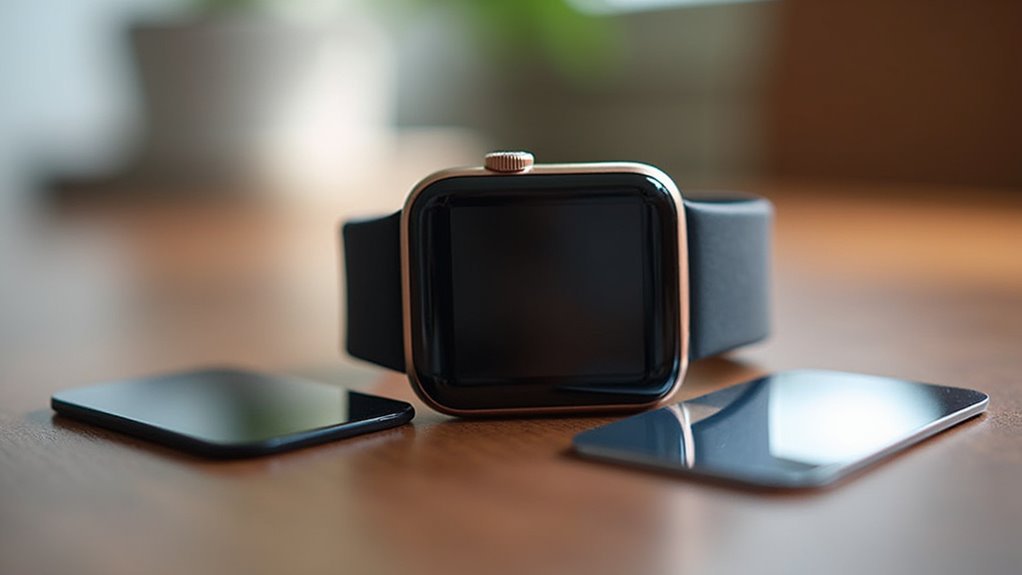
When protecting your smartwatch screen, five main materials dominate the market, each offering distinct advantages for durability and performance.
Tempered glass delivers excellent clarity and scratch resistance but shatters upon severe impact.
Hybrid glass combines glass with TPU layers, providing superior drop protection while maintaining visual quality.
InvisiGlass Ultra stands out as 40% stronger than tempered glass, featuring anti-fingerprint properties and ultra-slim design.
TPU plastic offers flexibility and easy installation but scratches more easily and may peel over time from clothing friction. Touch sensitivity can be severely compromised with some TPU options, requiring significant pressure to register taps on your smartwatch display.
PET flexible protectors provide high clarity with stress-free application, though they’re less scratch-resistant than glass options.
For maximum durability, consider your usage patterns—active users benefit from hybrid glass’s impact resistance, while casual users might prefer tempered glass’s scratch protection.
Master Bubble-Free Installation Techniques for Perfect Application
After selecting your ideal screen protector material, proper installation becomes the difference between crystal-clear protection and a frustrating mess of bubbles and misalignment.
Mastering installation technique transforms your screen protector from potential disaster into flawless, bubble-free protection for your device.
You’ll need to create the perfect environment and use proven techniques to achieve professional results.
Start by thoroughly cleaning your smartwatch screen with non-alcoholic wipes, then dry it completely with a microfiber cloth. Work in a dust-free space and use an anti-static cloth for final preparation.
Create a tape hinge on one side of your protector for precise positioning, then slowly lower it down while pressing from the center outward. Once applied, turn your watch back on to verify that touch functionality remains completely responsive and uncompromised.
- Clean the screen thoroughly and work in a dust-free environment
- Use painter’s tape to create a positioning hinge for accurate placement
- Apply pressure from center outward to prevent air bubble formation
- Address persistent bubbles immediately by lifting and reapplying sections
Understand Hardness Ratings and Protection Levels Before Buying
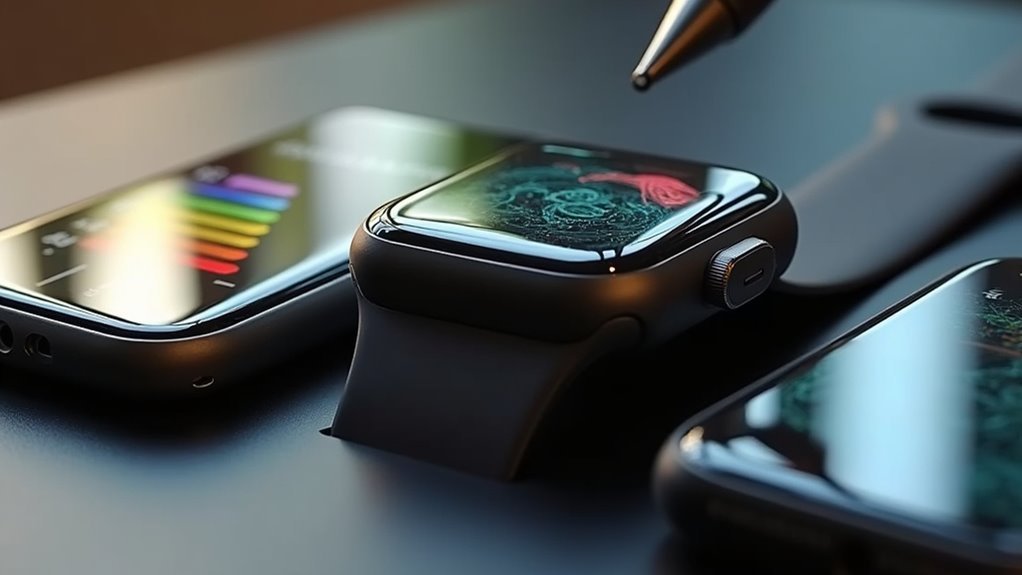
You’ll need to understand the Mohs scale rankings to choose the right protection for your smartwatch screen, as materials like sapphire crystal rate 9 while sand rates around 7.
Impact resistance levels determine how well your screen protector absorbs shocks from drops and bumps during daily wear.
Durability test standards help you compare different protection options by showing real-world performance against scratches, impacts, and environmental factors. Unlike smartphones that can use protective cases, smartwatches require built-in durability features since external protection options are limited.
Mohs Scale Material Rankings
Although most smartwatch buyers focus on features and design, understanding the Mohs scale can save you from costly screen replacement down the road. This 1-10 ranking system measures scratch resistance, helping you make informed decisions about screen materials.
Here’s what you need to know about key materials:
- Talc (1) and Gypsum (2): The softest minerals – avoid any screen materials in this range.
- Calcite (3) and Quartz (7): Standard glass falls between these levels, offering moderate protection.
- Corundum (9): Sapphire glass matches this hardness, providing exceptional scratch resistance.
- Diamond (10): The hardest material, though not practical for smartwatch screens.
Sapphire glass costs more upfront but delivers superior durability compared to standard alternatives. Remember that the Mohs scale measures only scratch resistance, not impact resistance or overall toughness.
You’ll protect your investment while maintaining crystal-clear visibility for years.
Impact Resistance Levels
While scratch resistance matters, your smartwatch’s ability to survive drops and impacts deserves equal attention when selecting screen protection.
Sapphire crystal glass excels at preventing scratches but cracks more easily under impact due to its hardness-focused design. Tempered glass protectors offer better impact resistance, withstanding drops and shocks more effectively while providing decent scratch protection.
You’ll find thicker protectors generally absorb more force, though they may slightly reduce touch sensitivity. Anti-shatter coatings on quality tempered glass prevent scattered fragments, enhancing safety.
Match your protection level to your lifestyle—high-impact environments demand maximum thickness and hardness ratings. Device-specific protectors guarantee proper coverage without gaps that compromise protection.
Look for military-grade certifications like MIL-STD 810H testing, which indicates superior impact resistance compared to unstandardized products. Consider that protective bezels on some smartwatch models can reduce direct glass impact, potentially allowing you to use thinner screen protection.
Durability Test Standards
Before investing in screen protection, understanding durability test standards helps you make informed decisions based on actual performance data rather than marketing claims.
The Mohs scale ranks mineral hardness from 1 (softest) to 10 (hardest), with glass typically rating 6–7 and sapphire crystal at 9.
Vickers hardness uses diamond-tip indentation testing, measured in HV units where higher numbers indicate greater resistance.
Pencil hardness scales (3H, 6H) rate resistance to scribing with graded pencils.
Key durability testing standards include:
- Mohs scale testing – Uses materials of known hardness to determine scratch resistance
- Vickers hardness measurement – Quantifies resistance through precise diamond indentation testing
- Pencil hardness grading – Evaluates surface resistance using standardized pencil grades
- Real-world simulation – Tests against everyday items like keys, coins, and environmental debris
Tempered glass protectors with anti-shatter coatings provide additional safety by preventing the glass from breaking into dangerous shards upon impact.
Select Full Coverage Options That Match Your Smartwatch Model
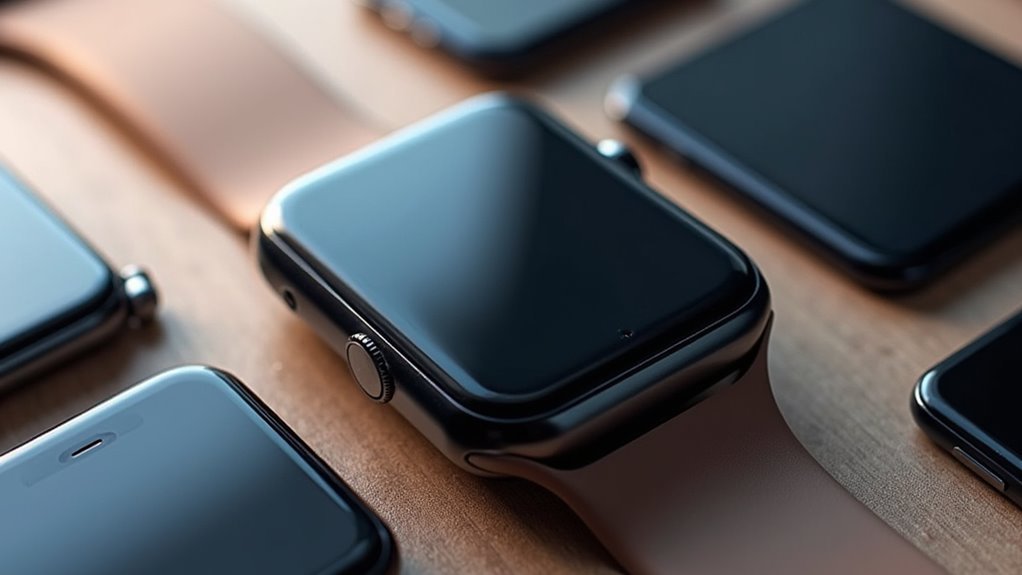
You’ll achieve ideal protection by choosing model-specific compatibility kits designed exclusively for your smartwatch’s exact dimensions and button placements.
Look for full screen coverage options that protect the entire display surface, including curved edges where scratches commonly occur.
Invest in precise fit solutions that align perfectly with your device’s sensors and charging ports, ensuring you don’t compromise functionality while maximizing protection. Consider options that maintain touch sensitivity to preserve the natural responsiveness of your smartwatch’s interface during daily use.
Model-Specific Compatibility Kits
Model-specific compatibility kits represent the gold standard for smartwatch screen protection, delivering precision-engineered solutions that generic protectors simply can’t match.
These tailored kits feature pre-cut tempered glass or film protectors that conform perfectly to your device’s exact dimensions and curvature, guaranteeing your sensors and buttons remain fully functional.
You’ll eliminate the frustrating bubbling and lifting issues common with ill-fitting generic alternatives. The precise cuts maintain your touchscreen sensitivity while keeping features like heart rate monitors and automatic brightness sensors completely unobstructed. Premium options utilize Tempered Corning Glass technology for enhanced durability and optical clarity.
- Perfect dimensional matching prevents edge chipping and protector peeling
- Installation tools included guarantee bubble-free application with alignment frames
- 9H hardness rating provides superior scratch resistance against sharp objects
- Multi-pack options offer replacement protectors for extended protection lifespan
Full Screen Coverage
When selecting full coverage screen protectors, you’re getting maximum protection that extends beyond just the display surface to include the entire front face of your smartwatch.
You’ll want to verify compatibility with your specific smartwatch model for peak performance, as incompatibility can lead to bubbles or reduced screen responsiveness.
Consider material options carefully – PET offers flexibility while tempered glass provides superior durability.
Look for high transparency levels to maintain clear visibility of your display. Many brands like Doubc Smart Watch offer convenient six-packs for long-term protection.
Check for additional features such as oleophobic coatings to reduce fingerprints and scratch resistance properties.
Remember that thickness can impact touch sensitivity, so balance protection with functionality when making your selection. Even with the best screen protectors, accidents can still happen, which is why insurance plans offer protection against accidental damage that physical protectors can’t prevent.
Precise Fit Solutions
Finding the right screen protector starts with verifying it’s specifically designed for your smartwatch model, as generic options often result in poor alignment, trapped air bubbles, and incomplete coverage around curved edges or sensors.
You’ll need to evaluate material choices that balance protection with usability. TPU offers flexibility and maintains touch sensitivity, while tempered glass provides superior scratch resistance. PET flexible models deliver stress-free application with fewer alignment issues.
Choose protectors with minimalistic designs that preserve your watch’s aesthetic appeal without adding bulk. The application process matters considerably—look for options that include alignment guides or wet-application methods to guarantee bubble-free installation. When shopping online, international customers can access a wider selection of specialized protectors by ordering from retailers that ship to any U.S. address or store location.
- Verify exact model compatibility before purchasing to guarantee precise cutouts for sensors and buttons
- Choose appropriate material thickness based on your protection needs versus comfort preferences
- Prioritize easy application features like alignment tools or bubble-free installation methods
- Select minimalistic designs that maintain your smartwatch’s original appearance and functionality
Maintain Proper Cleaning Routines to Prevent Scratch-Causing Debris
Since debris trapped beneath your smartwatch screen can cause permanent scratches with every swipe and tap, establishing a consistent cleaning routine becomes your first line of defense.
Regular cleaning prevents microscopic particles from becoming abrasive agents that transform routine touches into screen-damaging sandpaper interactions.
Use microfiber cloths exclusively—they’re soft enough to remove dirt without scratching delicate surfaces. Avoid paper towels and rough materials that’ll damage your screen.
Power off your device before cleaning and stick to chemical-free methods. A slightly damp microfiber cloth works for daily maintenance, while mild soap and water handles tougher grime.
For persistent buildup, try diluted isopropyl alcohol, but avoid touchscreen areas to protect oleophobic coatings.
Clean crevices with soft-bristled brushes and cotton swabs. Remove watchbands when possible for thorough cleaning. Consider your device’s waterproof capability before choosing your cleaning approach.
Daily wipe-downs prevent debris accumulation that causes scratches.
Evaluate Shatterproof and Shock Absorption Features for Active Lifestyles
Active lifestyles demand more than pristine screens—they require displays that won’t shatter when you’re mountain biking down rocky trails or working construction sites.
If you’re constantly on the move, prioritize smartwatches with sapphire crystal glass or toughened Gorilla Glass. These materials offer superior hardness and impact resistance compared to standard displays.
Look for models featuring military-grade MIL-STD 810G/H certification, which guarantees your watch survives extreme conditions.
E-ink displays excel in rugged environments due to their solid construction, while rubber bumpers and reinforced corners provide essential shock absorption. Additionally, consider watches with IP67 rating for comprehensive dust and water resistance protection.
- Choose sapphire crystal or Gorilla Glass for maximum scratch and shatter resistance
- Verify MIL-STD 810G/H certification for military-grade durability standards
- Select watches with rubber bumpers to absorb impacts effectively
- Consider E-ink displays for exceptional shock resistance in extreme conditions
Balance Clarity and Protection Without Compromising Display Quality
When you’re investing in a scratch-resistant smartwatch, you shouldn’t have to sacrifice crystal-clear visibility for protection. Premium materials like sapphire crystal glass deliver exceptional scratch resistance while maintaining brilliant display clarity—the Apple Watch Ultra 2 achieves 3,000 nits peak brightness despite its thick protective glass.
Gorilla Glass offers an excellent middle ground, preserving high light transmission and touch sensitivity while providing robust protection against daily wear.
You’ll want to avoid cheaper polymer films that can reduce display vividness and clarity. Instead, look for watches with oleophobic and anti-reflective coatings that combat glare and fingerprint marks without compromising screen readability.
Advanced bonded glass screens minimize air gaps, improving dust resistance while maintaining ideal display performance for long-term use. The Apple Watch Ultra 2 features a durable titanium construction that enhances overall scratch resistance beyond just the display.
Frequently Asked Questions
How Often Should I Replace My Smartwatch Screen Protector?
You should replace your smartwatch screen protector when it’s cracked, heavily scratched, or flaking off. Generally, replace it every 6-12 months or immediately when damage occurs.
Can I Use My Smartwatch Underwater With a Screen Protector Installed?
You can use your smartwatch underwater with a screen protector if it’s waterproof and properly installed. However, some protectors may affect touchscreen sensitivity when wet, so check compatibility first.
Will Screen Protectors Affect My Smartwatch’s Touch Sensitivity or Responsiveness?
Screen protectors can reduce your smartwatch’s touch sensitivity, requiring more pressure for actions to register. You’ll experience better responsiveness with high-quality, thin protectors that fit precisely without air bubbles.
Do Screen Protectors Interfere With Heart Rate Sensors or Other Biometric Features?
Screen protectors can interfere with your heart rate sensors if they block light transmission. They might also affect blood oxygen monitoring and facial recognition, but won’t impact ECG or fall detection features.
What’s the Average Cost Difference Between Basic and Premium Screen Protectors?
You’ll find basic screen protectors cost $5-15, while premium ones range $20-60. That’s roughly a $15-45 price difference, with premium options offering advanced features like anti-microbial coatings and stronger scratch resistance.
In Summary
You’ve got everything you need to keep your smartwatch screen pristine. Don’t skimp on quality materials, and take your time with installation. Remember, the right protector won’t compromise your display’s clarity while delivering serious protection. Keep up with regular cleaning, and choose features that match how you actually use your device. Your smartwatch screen can stay flawless with these protective strategies in place.

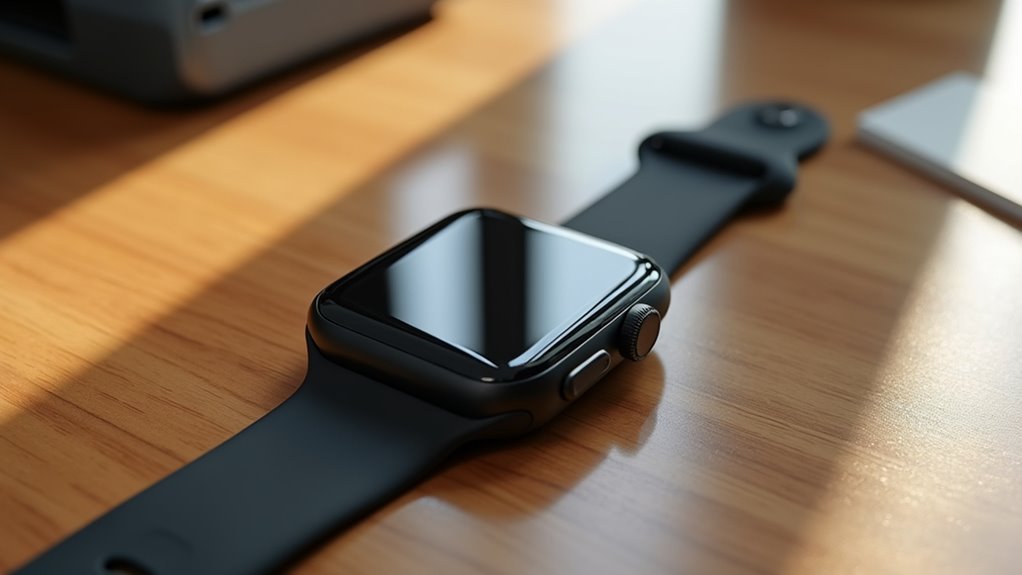
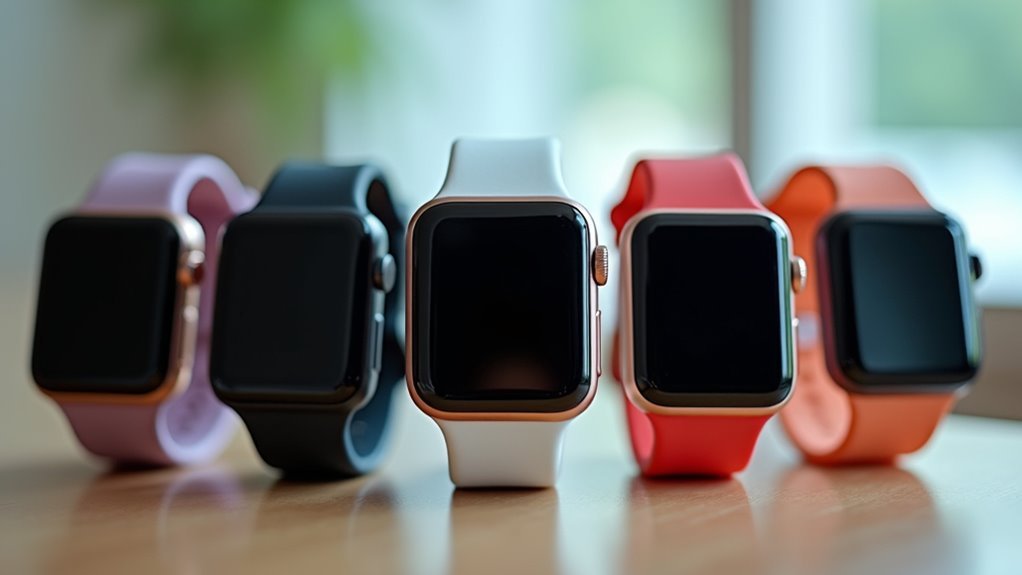
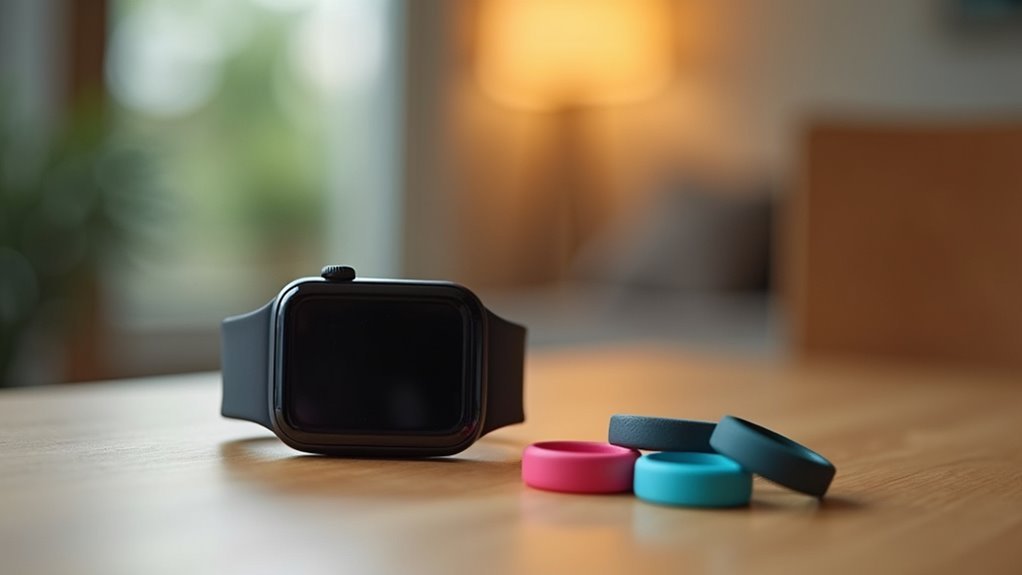
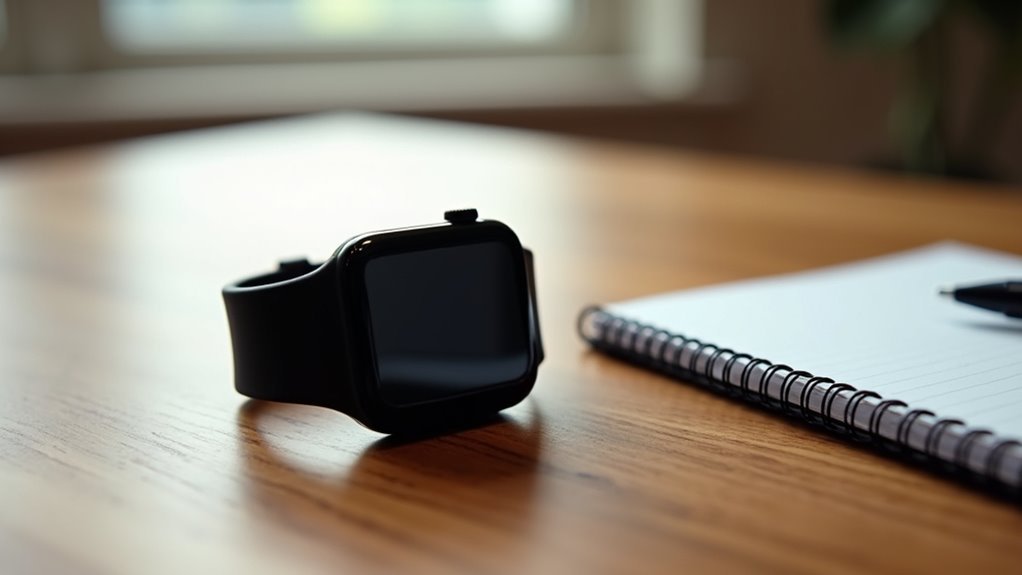
Leave a Reply